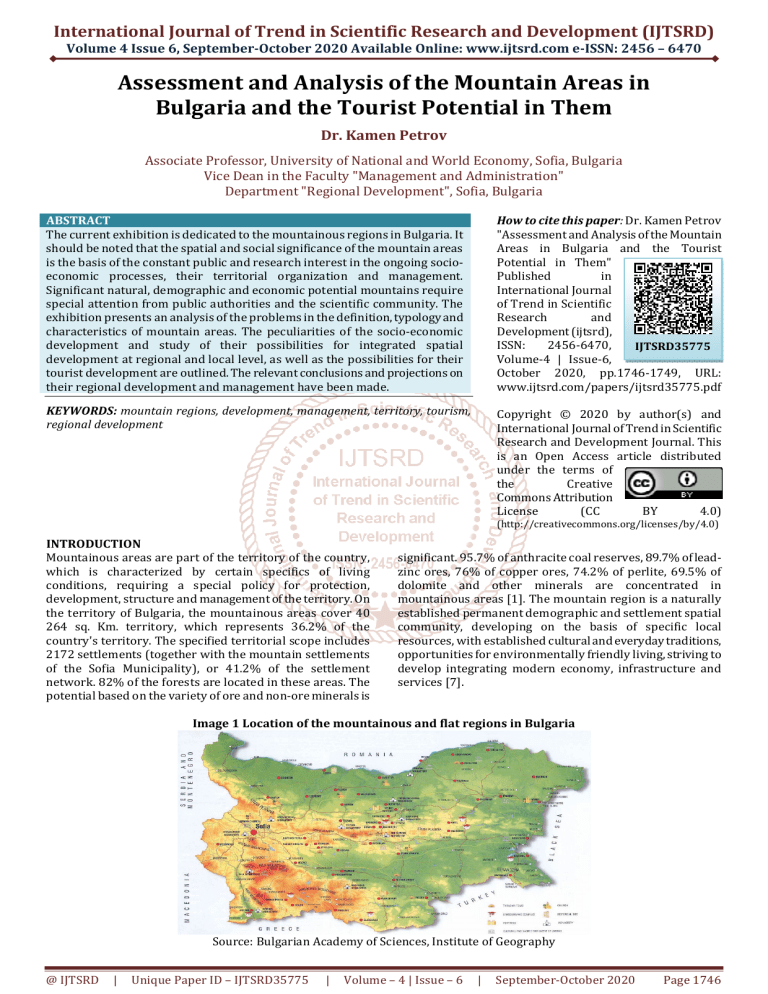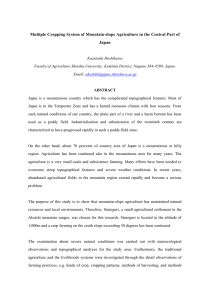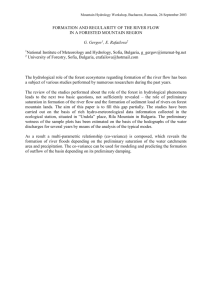
International Journal of Trend in Scientific Research and Development (IJTSRD)
Volume 4 Issue 6, September-October 2020 Available Online: www.ijtsrd.com e-ISSN: 2456 – 6470
Assessment and Analysis of the Mountain Areas in
Bulgaria and the Tourist Potential in Them
Dr. Kamen Petrov
Associate Professor, University of National and World Economy, Sofia, Bulgaria
Vice Dean in the Faculty "Management and Administration"
Department "Regional Development", Sofia, Bulgaria
ABSTRACT
The current exhibition is dedicated to the mountainous regions in Bulgaria. It
should be noted that the spatial and social significance of the mountain areas
is the basis of the constant public and research interest in the ongoing socioeconomic processes, their territorial organization and management.
Significant natural, demographic and economic potential mountains require
special attention from public authorities and the scientific community. The
exhibition presents an analysis of the problems in the definition, typology and
characteristics of mountain areas. The peculiarities of the socio-economic
development and study of their possibilities for integrated spatial
development at regional and local level, as well as the possibilities for their
tourist development are outlined. The relevant conclusions and projections on
their regional development and management have been made.
How to cite this paper: Dr. Kamen Petrov
"Assessment and Analysis of the Mountain
Areas in Bulgaria and the Tourist
Potential in Them"
Published
in
International Journal
of Trend in Scientific
Research
and
Development (ijtsrd),
ISSN:
2456-6470,
IJTSRD35775
Volume-4 | Issue-6,
October 2020, pp.1746-1749, URL:
www.ijtsrd.com/papers/ijtsrd35775.pdf
KEYWORDS: mountain regions, development, management, territory, tourism,
regional development
Copyright © 2020 by author(s) and
International Journal of Trend in Scientific
Research and Development Journal. This
is an Open Access article distributed
under the terms of
the
Creative
Commons Attribution
License
(CC
BY
4.0)
(http://creativecommons.org/licenses/by/4.0)
INTRODUCTION
Mountainous areas are part of the territory of the country,
which is characterized by certain specifics of living
conditions, requiring a special policy for protection,
development, structure and management of the territory. On
the territory of Bulgaria, the mountainous areas cover 40
264 sq. Km. territory, which represents 36.2% of the
country's territory. The specified territorial scope includes
2172 settlements (together with the mountain settlements
of the Sofia Municipality), or 41.2% of the settlement
network. 82% of the forests are located in these areas. The
potential based on the variety of ore and non-ore minerals is
significant. 95.7% of anthracite coal reserves, 89.7% of leadzinc ores, 76% of copper ores, 74.2% of perlite, 69.5% of
dolomite and other minerals are concentrated in
mountainous areas [1]. The mountain region is a naturally
established permanent demographic and settlement spatial
community, developing on the basis of specific local
resources, with established cultural and everyday traditions,
opportunities for environmentally friendly living, striving to
develop integrating modern economy, infrastructure and
services [7].
Image 1 Location of the mountainous and flat regions in Bulgaria
Source: Bulgarian Academy of Sciences, Institute of Geography
@ IJTSRD
|
Unique Paper ID – IJTSRD35775
|
Volume – 4 | Issue – 6
|
September-October 2020
Page 1746
International Journal of Trend in Scientific Research and Development (IJTSRD) @ www.ijtsrd.com eISSN: 2456-6470
The same applies to hydro resources, recreational,
balneological and other resources. The relative share of the
territory, exclusive state property of the total territory of the
mountain municipalities ranges from 50 to 80%. The
mountainous areas include territories with special regimes 6 national parks with an area of 271 thousand hectares, 35
protected areas - 8.6 thousand hectares, 134 natural
landmarks - 8.8 thousand hectares and 72 reserves - 68.8
thousand. hectares [1]. Mountainous areas are generally
characterized by high river network density, high runoff
modulus and relatively stable river runoff characteristics. Of
these, 81.3% of the total runoff is formed and 70% of the
swamped water volume of Bulgaria is concentrated. They
are extremely rich in thermo-mineral waters, which are not
used enough. Sources with a total flow rate of about 3 cubic
meters per second have been discovered, of which no more
than half are used. The mountains Rila, Pirin, Western and
Central Stara Planina, the Western Rhodopes and the
southern part of the Eastern Rhodopes are characterized by
favorable characteristics in terms of surface waters. Relative
to the western border, Sredna Gora, Strandzha and Sakar.
Only Rila and Pirin are rich in lakes - about 280 lakes.
Defining the scope and structure of mountain areas in
Bulgaria
Normative regulation of the criteria, indicators and scope of
settlements falling in the mountainous areas in the Republic
of Bulgaria - adoption of a system of criteria and indicators
for refining the concept of “mountainous region” and a list of
settlements falling within the scope of mountainous areas.
In all studied European legislations the main criterion for
determining the type of the area is the morphometry of the
relief. It is defined by the altitude indicator, with a limit of
600 meters above sea level. In the French legislation, in
addition to the indicated altitude, the displacement of the
relief is accepted, which between the highest and lowest
points should not be less than 400 m. This characteristic
must cover more than 80% of the territory of the
municipalities in order to be included in mountain areas [3].
Given that the French mountains are compact and the
municipalities (communes) are many times smaller in area,
these criteria are sufficient for the objective identification of
their mountain areas. The main parallel location of the
mountains in Bulgaria, the fragmentation of the compact
mountain territories and the valleys located between them
cannot be covered only by the indicated criteria. For
Bulgaria, 3 additional but very important criteria have been
adopted: depth of relief dissection, density of
dismemberment and terrain slopes. They are applied only in
combination with the main criterion - altitude. Depth of
relief of the relief, expressing the ratio between the altitudes
of the highest and the lowest point per unit area / sq.km./.
To determine the mountain character, an indicator with
displacement of the terrain with a value of over 200 m was
adopted. The difference between the lowest and the highest
point per 1 sq. Km. Density of relief of the relief, expressing
the degree of incision of the topographic surface. It is
measured by the length of the haul net in km. (river valleys,
valleys, dry valleys, plains), per unit area - also 1 sq. km. The
indicator used according to this criterion has a value of over
2 km / sq. Km. Slope of the terrain, expressing the ratio
between the depth and the density of the relief dissection. In
determining the mountain areas, the main criterion was
"altitude". In cases where the complementary criteria have
@ IJTSRD
|
Unique Paper ID – IJTSRD35775
|
unfavorable indicators, their corrective effect on the main
criterion is taken into account. According to their
quantitative parameters, these indicators have played a
significant role in the inclusion of areas below 600 m in the
category "mountain" (at high values) or in the exclusion of
areas over 600 m from the same category (at low values).
The criteria and indicators used to determine settlements
and territories with the status of "mountain" are of a static
nature, which is a guarantee for a permanent range of
mountain areas. Applying the system of criteria and
indicators (by using large-scale topographic maps) the
mountain settlements in the Republic of Bulgaria are
determined, 41.8% of the total number of settlements in the
country, and the mountain municipalities (40% of the
municipalities).
It is important to note that there is a category of
municipalities whose settlement network includes over 50%
of settlements with a mountainous character and
compactness of the territory [2]. This classification is used in
formulating a policy for regional development of certain
compact areas. Thus low-mountainous - covering the
territories with an altitude of 600 to 1000 m. The object of
priority development in this zone are economic activities in
the sectors of mountain agriculture and animal husbandry,
industrial enterprises for ecologically clean production,
tourist activities. Mid-mountain - covers areas with an
altitude of 1000 to 1500 m. Objects for priority development
are forestry, mountain livestock, tourism. Alpine - covering
the territories with altitude over 1500 m -, which are subject
to priority protection and limited regime in the use of
resources.
Figure 2 Separation of mountain areas in Bulgaria
Source: Bulgarian Academy of Sciences, Institute of
Geography
Socio-economic and demographic condition of the
mountainous areas
In recent decades, a number of decisions of the Council of
Ministers have been adopted, which are a legal attempt to
improve certain working and living conditions of part of the
population in mountainous areas - mainly on the southern
and western borders of the country. Subsidies and other
measures granted by the state are mainly aimed at
additional payments to the salary, provision of transport
from the place of residence to the place of work to
administrative privileges for some specialists and others [3].
After Bulgaria's accession to the European Union, the
mountainous regions are largely a new center of attraction
for regional development. There have been partial successes
in attracting investment in light industry, tourism and
services. The positive findings for mountain areas is the
Volume – 4 | Issue – 6
|
September-October 2020
Page 1747
International Journal of Trend in Scientific Research and Development (IJTSRD) @ www.ijtsrd.com eISSN: 2456-6470
contrast of the mountain with the global XXI century. In
practice, the Bulgarian mountains are a place where the
somewhat authentic tradition of the Bulgarian people has
been preserved. Of course, the emerging socio-economic
difficulties. Deteriorating infrastructure, lack of
implementation of large infrastructure projects and
especially demographic deficits. In this direction it is normal
to look for opportunities for tourism development in
mountainous areas.
Accepting the experts' assessment that the mountain areas
have not been in good socio-economic condition for the last
30 years, it is normal to look for new solutions.
It is necessary to define in more detail the specifics of the
regional features, as well as the distinction of these regions
from the rest of the country, with a lasting, permanent
objective basis for reducing the socio-economic activity in
them.
The demographic picture of the mountainous areas shows
that they are characterized by a pronounced dispersed
displacement. There are 66 cities located in them, mostly up
to 10 thousand people with 49.3% of the population. The
villages are twice as small, with an average size of one village
of 300 people, compared to 625 people for the plains. The
mountainous areas are historically less populated, but in
most of them the depopulation has reached drastic
proportions. With a total population density of 34 people /
sq. Km., In the plains it is about 85, as in Strandzha - Sakar it
is only 7, in Kraishtensko - Sofia it is up to 20 d / sq. Km.
With the exception of a few small towns in the Fore Balkans, the Strandzha region is the largest depopulated
region in the country, with a very old population including
mountainous areas. In most of the mountainous areas, the
villages have lost their functions, and the supporting
settlement network is represented by several very small
towns with limited influence within the municipalities [4].
The employment structure of the population from the
mountainous areas largely reflects their economic functions.
The leading place of the agricultural sector, forestry and
tourism is determined by the relatively high number of
employees in these industries - over 40%. The statistical
information does not give a real idea of the actual
employment in the agricultural sector in the conditions of
restitution of agricultural lands. Some of the landowners
realize income from self-rent. Their number varies greatly
and is statistically difficult to cover. The unemployment rate
in the mountainous regions is significantly higher than the
national average / about 18 - 20% compared to 13% for the
Republic of Bulgaria /. To this is added the seasonal nature
of employment (agriculture, forestry, tourism), which
significantly affects the income of the population in rural
areas.
Infrastructure security of mountain areas
Of particular importance for the normal life and economic
functioning of mountain areas is the condition of the
individual infrastructure systems: transport, water
management, communications and energy. In the
predominant part of the transport infrastructure in the
mountainous regions there is a satisfactory construction of
the road, in comparison with the railway network, due to its
easier adaptation to the specific natural conditions. Variation
in a large range of the density of the constructed road
@ IJTSRD
|
Unique Paper ID – IJTSRD35775
|
network, as a result of which whole regions have been
formed, in which it is below the average for the country - the
mountains in Southwestern Bulgaria, the Western Rhodopes,
Strandzha, Sakar, Western Stara Planina. Significant distance
/ above the rational minimum / from the built railway.
network of a large part of the mountainous territories. The
most critical in this respect are the Rhodopes, Strandzha and
Sakar. Dead-end completion of a large part of the built
railway infrastructure, which repeatedly narrows its area of
influence. Communications as an element of the technical
infrastructure also have specific features related to the
quantity and quality of services provided and do not create
prerequisites for satisfactory service to the population and
business, especially in mountainous and remote from larger
cities mountain villages. It could be noted that in general the
mountainous areas in the country are characterized by low \
and uneven telephone density (about 2 times lower than the
national average).
The repeated increase of the anthropogenic pressure on the
natural environment has caused a number of specific
ecological problems in the mountainous areas, where there
are territories with difficult ecological condition.
Despite the described problems, the mountainous regions in
Bulgaria are characterized for the most part by good
ecological condition and preserved natural landscape with
extremely rich diversity. This implies that, based on the
specific natural, economic, demographic, social and
infrastructural conditions of mountain areas and in our
vertical areas, the systems of incentive and preferential
mechanisms for the development of sectors of the economy
related to the use of local resources and the protection of the
richest biological fund of the country.
The experience of a number of European countries and the
conclusions made from the research conducted in our
country show that under the new socio - economic
conditions the solution of most of the problems of the
mountainous regions requires the implementation of a
special policy. In this direction, the approach to the
mountainous regions should be more precise, because, for
example, in the distribution of the land fund - in the
mountainous regions the agricultural fund occupies 37.5%
against 75.5% in the rest of the country. Even more
contrasting is the difference in the forest fund, which here
represents 60.7%, and in the rest it is only 19.9%. This
shows that there must be an integrated approach to the
management of mountain areas in Bulgaria [5].
Such a focus can bring to the fore the development of
different types of tourism. In order to realize the need to
overcome the negative processes, serious efforts and
effective measures are needed, a consistent national policy is
needed for their effective protection, use and development.
This policy should be aimed at gradually controlling the
processes of depopulation, the disappearance of economic
functions and traditional activities and the creation of new
perspectives for the development of the mountainous parts
of Bulgaria.
Opportunities for tourism development in mountainous
areas
Regarding the management and utilization of the
recreational potential of the mountainous areas, a number of
Volume – 4 | Issue – 6
|
September-October 2020
Page 1748
International Journal of Trend in Scientific Research and Development (IJTSRD) @ www.ijtsrd.com eISSN: 2456-6470
problems emerge, such as: Exceeding the opportunities for
reproduction of natural recreational potential from the
capacity of some of the resorts such as "Borovets",
"Pamporovo" and others. Permit construction of tourist
catering facilities and hotels in inadmissible proximity to
protected sites. Underestimation of the aesthetic principles
in the construction of tourism sites, as some are not
consistent with the landscape silhouette of the territory.
Excessive concentration in the resorts of tourist facilities in
the service sector / cafes, restaurants, etc./, which during the
active season brings them closer to the conditions in the
residential areas of large cities and reduces their tourist
attractiveness. Insufficient technical infrastructure,
especially access to resorts. Inefficient use of some of the
geothermal and mineral waters and others. The further
utilization of the tourist potential is connected with a new
policy in the field of tourism, providing expansion of the
tourist product with sustainable use of the resources and the
environment[6].
Conclusion
The development of the mountainous regions in the country
and the preservation of their identity requires a
comprehensive policy that meets the criteria for sustainable
development. In this regard, one can think of drafting a
special Law on Mountains, which will address issues related
to sustainable development and development of mountain
areas. With its membership in the European Union, Bulgaria
can develop new effective measures to overcome the crisis
and for future sustainable development of mountainous
areas in Bulgaria. That is why it is necessary to stimulate the
economy and strengthen the mountain municipalities. It is
necessary to strengthen measures for economic and social
support and improvement of the living conditions of the
mountain population. Especially for the development of
mountain tourism in all its forms in accordance with the
natural and ecological balance and sustainability. Reasonable
use of land, resources, land and forest is needed. Formation
of a reasonable policy for the development of tourism and
other new activities in the mountains, carried out jointly, in
conjunction and without conflict with the traditional
mountain activities of the local population. Preservation of
the rich cultural and historical heritage and mountain
settlements and showing respect for the traditional way of
life of the local population, for the preservation of cultural
values, traditions and customs. Mountain development
@ IJTSRD
|
Unique Paper ID – IJTSRD35775
|
policy must be an integrated policy that covers economic,
social, environmental and development issues and
approaches.
It should coordinate and coordinate the diverse interests and
rights, to stimulate partnership and agreement between
different bodies, institutions and individuals, to promote the
achievement of harmony in relationships and harmony
between human activities and nature. Therefore, the
complex nature of the policy for the development of
mountain areas requires the use of a system of mechanisms
and regulators in order to overcome the regional differences
in these areas of the country.
Reference:
[1] Varbanov, M., G. Alexiev, Ch. Mladenov, N. Ilieva, M.
Nikolova, Z. Mateeva, R. Vatseva, B. Kulov (2015)
Determining the territorial scope of mountainous,
semi-mountainous and border regions in Bulgaria at
the municipal level for the purposes of developing a
targeted investment program for development of
lagging areas. National Institute of Geophysics,
Geodesy and Geography - BAS
[2]
Copus, A. K., Price, M. F. A Preliminary
Characterisation of the Mountain Area of Europe.
Euromontana, Brussels. 2002.pp. 8-17
[3]
Mountain Areas in Europe: Analysis of mountain
areas in EU member states, acceding and other
European countries. Final report. European
Commission contract No 2002.CE.16.0. AT.136. NCSD.
2004.
[4]
Patarchanova, Em.(2015) For some socio-economic
processes in Bulgarian villages , Mathematics and
Natural Sciences, Proceedings of the Fifth
International Sciences Conference – FMNS 2015 pp
35-41.
[5]
Patarchanova, Em, P. Patarchanov (2015) Sociodemographic studies of mountainous areas in
Bulgaria, "Geography and Regional Development"
2015:.
[6]
Patarchanov, P. (2017) Anniversary international
scientific and applied conference – UARD, Bulgaria
New knowledge journal of science ISSN 1314 -5703
Volume – 4 | Issue – 6
|
September-October 2020
Page 1749





